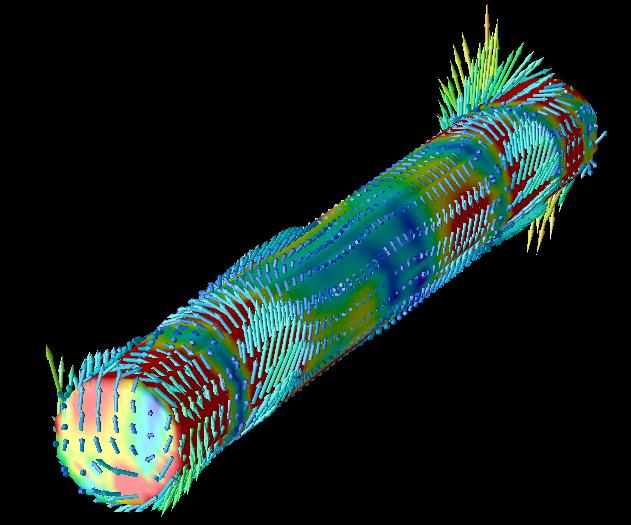Introduction
Nanophotonics is a rapidly developing new area of science of great importance for technology and basic science. It is based on new materials incorporating inclusions of nanoscale size. These materials do not exist in nature and they display exotic properties which can be used for design of new optical devices with superb characteristics. Nanophotonics studies the interaction of light with structures formed by nanoparticles.These subjects must be studied using a combination of mathematical analysis, ideas from theoretical physics, quantum mechanics and numerical simulation.

Local field enhancement of resonant nanostructures
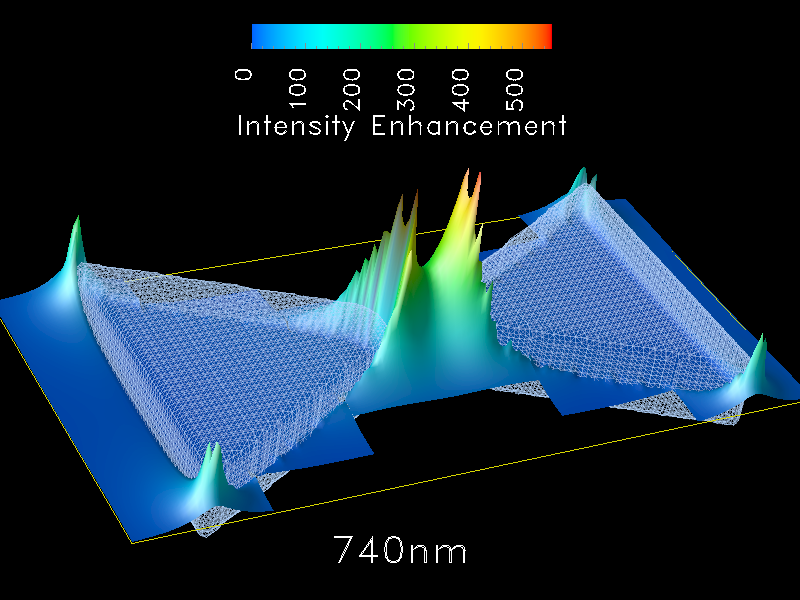 At the ACMS we simulated the resonant behavior of metallic nano-structures using a local mesh refinement FDTD method in 3-Dimensions. The influence of shape and tip geometry on the resonance structure and optical field intensity was examined.
At the ACMS we simulated the resonant behavior of metallic nano-structures using a local mesh refinement FDTD method in 3-Dimensions. The influence of shape and tip geometry on the resonance structure and optical field intensity was examined.
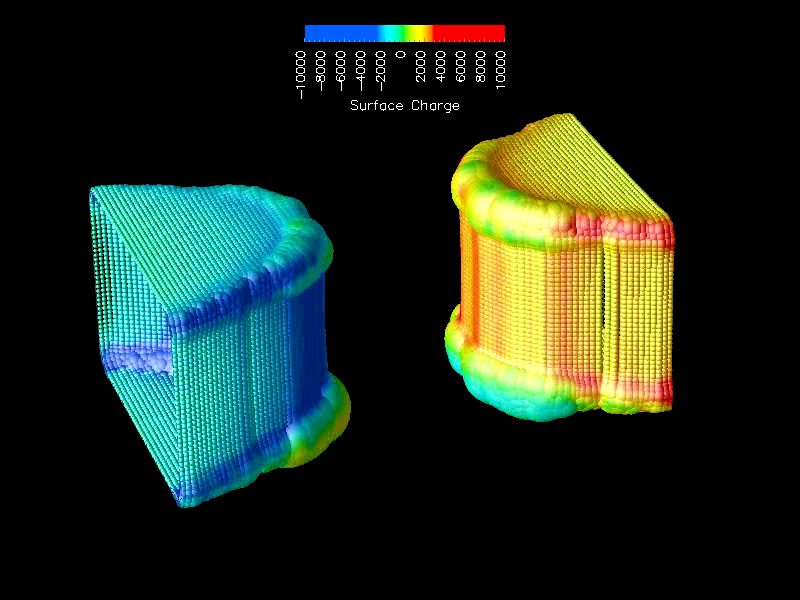 To accurately resolve sub-wavelength geometrical features when modeling nanoscale photonic structures, we employ the AMR-FDTD method with local space and time grid refinement using a 3D grid interface interpolation algorithm that preserves the second-order accuracy of the original FDTD scheme and is stable for long time integration.
To accurately resolve sub-wavelength geometrical features when modeling nanoscale photonic structures, we employ the AMR-FDTD method with local space and time grid refinement using a 3D grid interface interpolation algorithm that preserves the second-order accuracy of the original FDTD scheme and is stable for long time integration.
Using Adaptive Mesh Refinement not only gives detailed access to the near field structure of the enhanced fields at the tips but also enables us examine the subtle relation between small geometry perturbations and resonant wavelength.
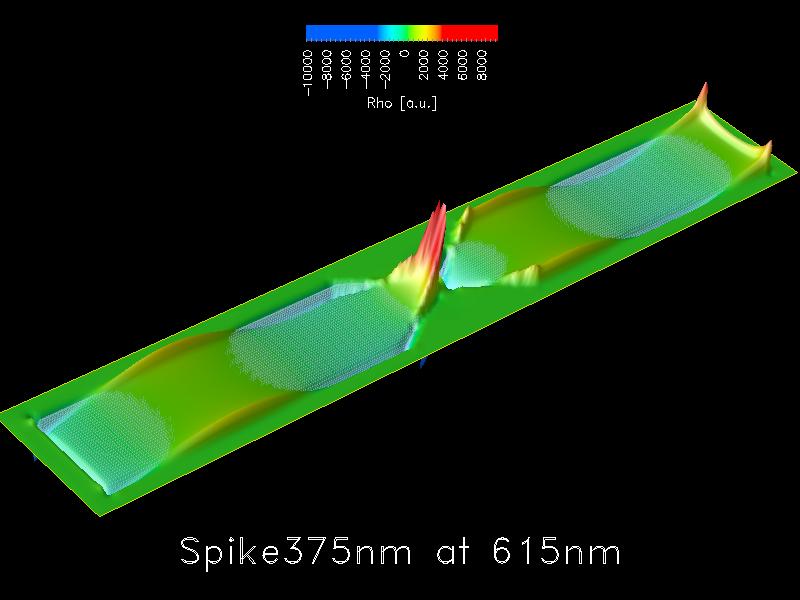
Also shown are instantaneous surface charge density slices through the top surface of a spike structure at resonant incident wavelengths.
The topology of the surface charge density for the order 0 resonance shows charges of opposite sign at the ends of each spike with increased charge density at sharp corners.
The charges at the gap tips are of opposite sign resulting in large field gradients across the gap. A time instantaneous snapshot of the order 1 polariton mode at 615nm, shows that the surface charge density at the gap tips is reduced resulting in lower field enhancement in the gap.
References
- C Dineen, M. Reichelt, A. R. Zakharian, J. V. Moloney, and S. W. Koch, "Local Field Enhancement and Spectral Response of Resonant Nanostructures", International Conference on Lasers and Electro-Optics (CLEO), Baltimore, Maryland May 6, 2007
- M. Reichelt, C Dineen, A. R. Zakharian, J. V. Moloney, and S. W. Koch, "Electromagnetic Interaction between Nanoparticles and Optical Subwavelength Devices", International Conference on Lasers and Electro-Optics (CLEO), Baltimore, Maryland May 6, 2007
- J.V. Moloney, A. R. Zakharian, C. Dineen, and M. Brio, "AMR FDTD solver for nanophotonic and plasmonic applications", Proc. SPIE 5451, 97 (2004), DOI:10.1117/12.548983

Optical forces on Quantum Dots
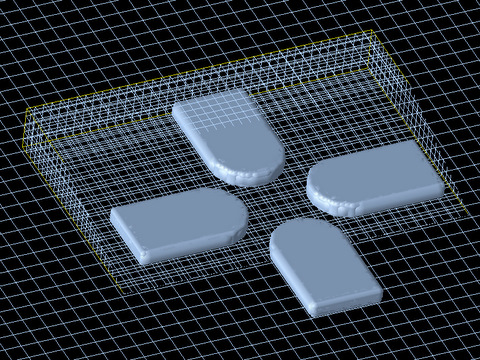 We examine the forces on a single quantum dot in the presence of resonantly enhanced electric fields and steep field gradients confined to a sub-wavelength region in the near field of the nano-structure. We examine the forces on a single quantum dot in the presence of resonantly enhanced electric fields and steep field gradients confined to a sub-wavelength region in the near field of the nano-structure. 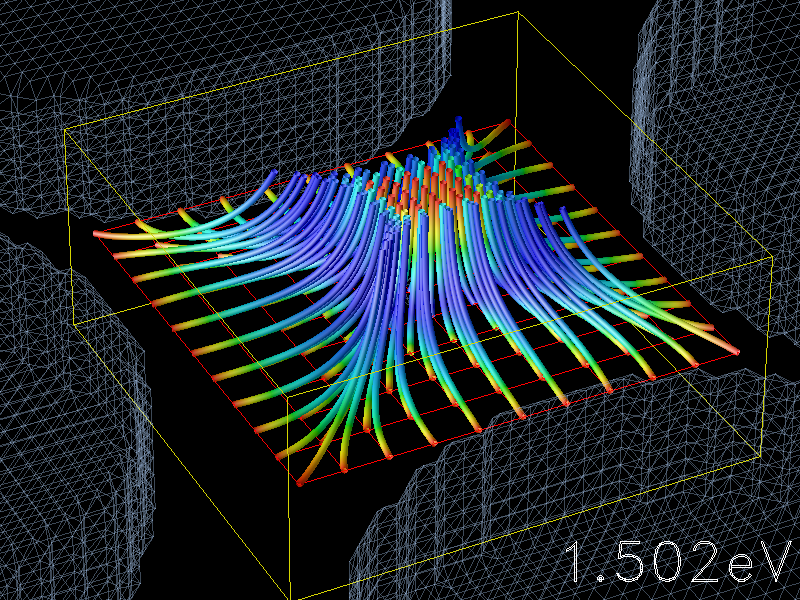
Using AMR-FDTD gives detailed access to the near field structure of the enhanced fields and consequently the gradient forces experienced by the quantum dot (QD) located near the tips.
The light-matter interaction between the QD and the metallic structure is computed self-consistently and the optical response, P(r,t), of the QD is modeled microscopically within the density matrix framework. The direction and net force on the QD, a combination of gradient and absorption forces, is controlled by the detuning of the incident wavelength from the resonance of the QD.
References
- M. Reichelt, C Dineen, A. R. Zakharian, J. V. Moloney, and S. W. Koch, "Electromagnetic Interaction between Nanoparticles and Optical Subwavelength Devices", International Conference on Lasers and Electro-Optics (CLEO), Baltimore, Maryland May 6, 2007
- C. Dineen, M. Reichelt, A. R. Zakharian, J. V. Moloney, and S. W. Koch, "Optical forces on Quantum dots in the near field region of resonant metallic nano-structures," in CLEO/Europe and IQEC 2007 Conference Digest, Optical Society of America, 2007

Nano-trap for the Optical Confinement of Quantum Dots
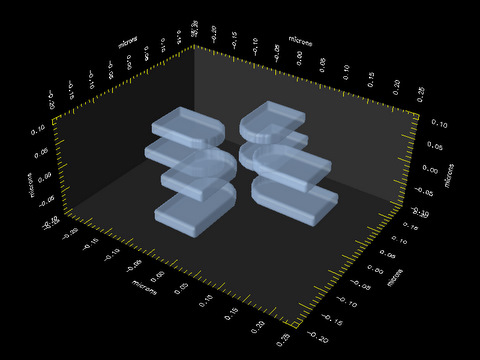 The use of optically induced forces to manipulate nano- and molecular scale objects has attracted considerable interest in recent years. Recently a number of surface plasmon based configurations have been proposed that employ enhanced evanescent fields, bound at metal/dielectric interfaces, to produce spatial intensity variations in the near-field of metal nano-structure capable of trapping nanoscale objects to a sub-wavelength region with forces on the order of femtonewtons. The use of optically induced forces to manipulate nano- and molecular scale objects has attracted considerable interest in recent years. Recently a number of surface plasmon based configurations have been proposed that employ enhanced evanescent fields, bound at metal/dielectric interfaces, to produce spatial intensity variations in the near-field of metal nano-structure capable of trapping nanoscale objects to a sub-wavelength region with forces on the order of femtonewtons.
We numerically model a metallic nano-structure in which coupling between the light field and the collective oscillations of the electron gas leads to a plasmon-polariton mode that can be tuned to match the optical resonance of a semiconductor quantum dot.
The optically induced scattering and gradient forces acting on the dot are resonantly enhanced by orders of magnitude above the force contributions originating from the polarization of the background dielectric constant alone. 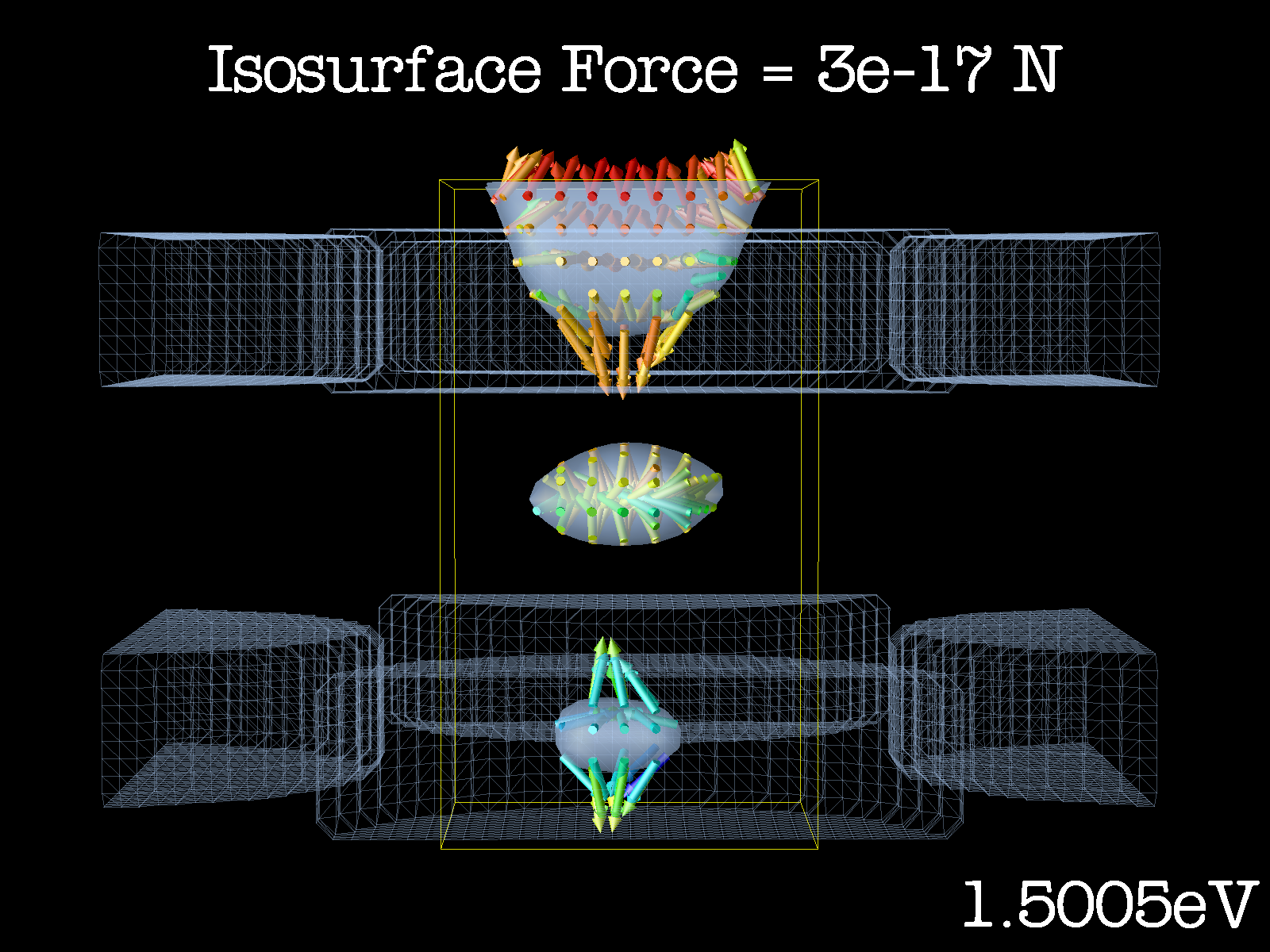
We numerically computed the optical forces on a single quantum dot, under excitonic resonance conditions, in the presence of resonantly enhanced electric fields and steep field gradients in the near-field of a suitably engineered metal nano-trap. The numerical scheme to compute the electromagnetic force on a quantum dot employs adaptive mesh refinement FDTD code to resolve deep sub wavelength structural details combined with microscopic material equations to model the optical response of the quantum dot.
By simultaneously solving the vector Maxwell equations and the microscopic material equations it is possible to arrive at an expression that includes both the gradient and the radiation pressure contributions as required for optimal trap design. The AMR-FDTD code is applicable to inhomogeneous fields on very short length scales by using a grid refinement. It has been shown that for the stated structure layout and dimensions and under the proper excitation conditions a quantum dot can be confined in three dimensions.
References
- C. Dineen, M. Reichelt, S. W. Koch, and J. V. Moloney, "A Plasmonic Nano-Trap for the Optical Confinement of Quantum Dots," in Optical Trapping Applications, OSA Technical Digest (CD) (Optical Society of America, 2009), paper OTuB5.
- Reichelt, M.; Dineen, C.; Koch, S.W.; Moloney, J.V.; "Optical Forces on a Quantum Dot in Metallic Bowtie Structures", IEEE Photonics Technology Letters, Volume 20, Issue 6, March 15, 2008 Page(s):431 - 433

Second-harmonic generation from metallic Metamaterials
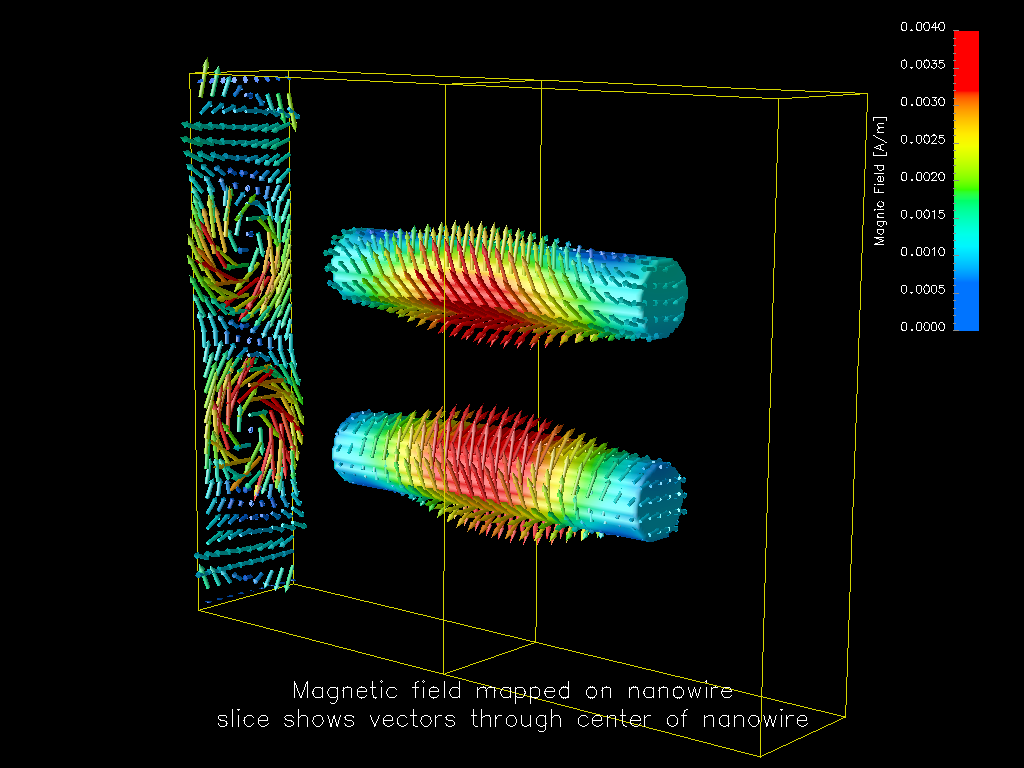
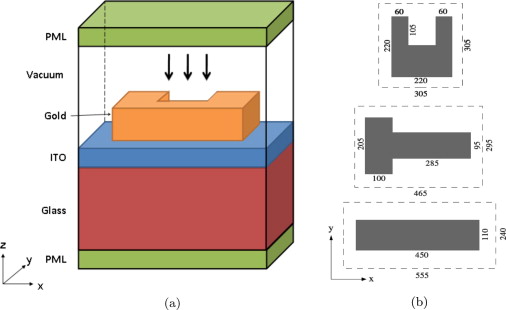
This work was motivated by recent experiments of second-harmonic generation (SHG) from metallic MMs. The SHG has been found to be the strongest when the non-centro-symmetric U-shaped metallic split-ring resonators (SSRs) were excited resonantly in comparison to other structures, such as T-shaped and rectangular metal pieces.
For centro-symmetric structure such as an array of metallic rectangular sections, the detected second-harmonic strength is much smaller (less than 1%) than that from U shapes. Numerical simulations were carried out by expanding electric and magnetic fields as well as charge and current densities into first-order linear response and second-order nonlinear response.
References
- Y. Zeng, C. Dineen, and J.V. Moloney, "Magnetic dipole moments in single and coupled split-ring resonators", Physical Review B. 81(1) 2010.
- Y. Zeng, W. Hoyer, J. Liu, S. W. Koch, and J.V. Moloney, "Classical theory for second-harmonic generation from metallic nanoparticles", Phys. Rev. B 79, 235109 2009.
|

